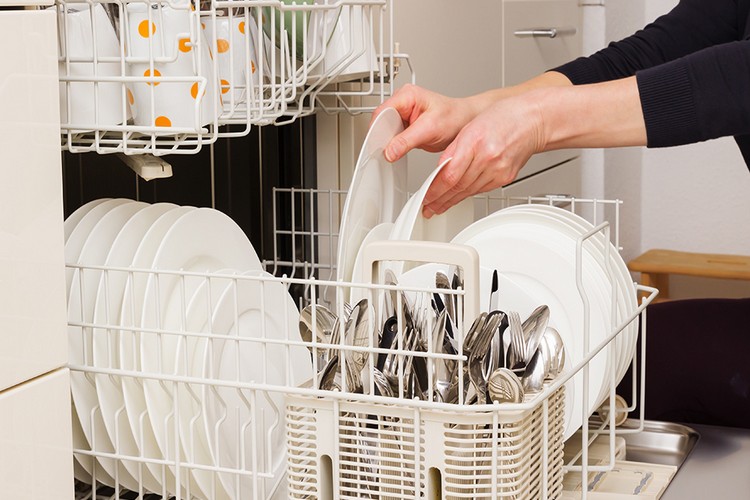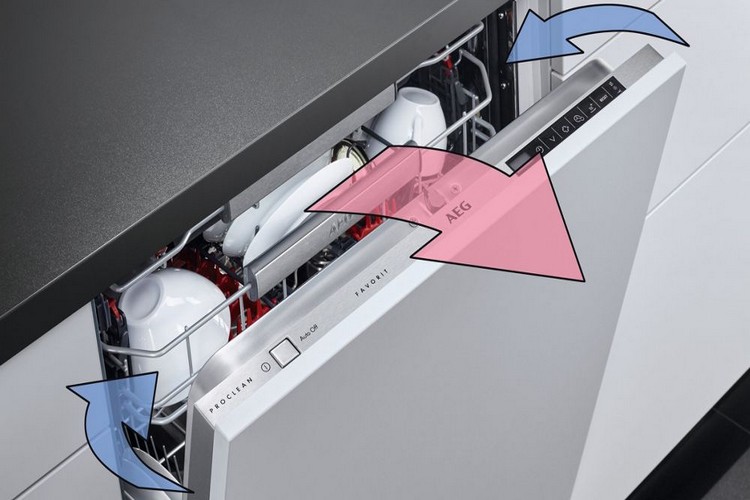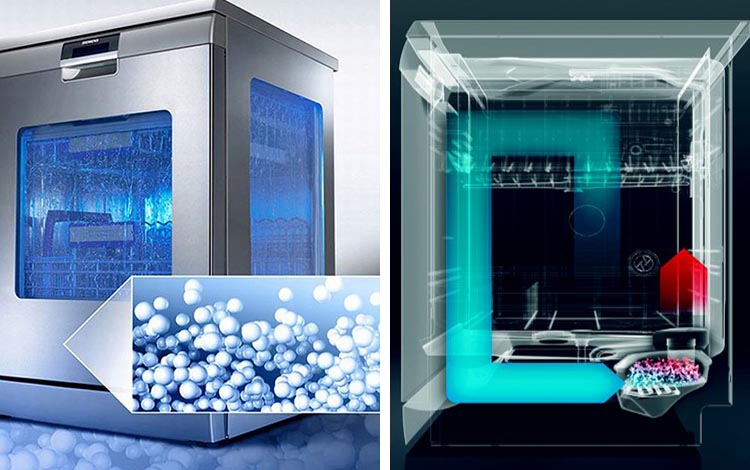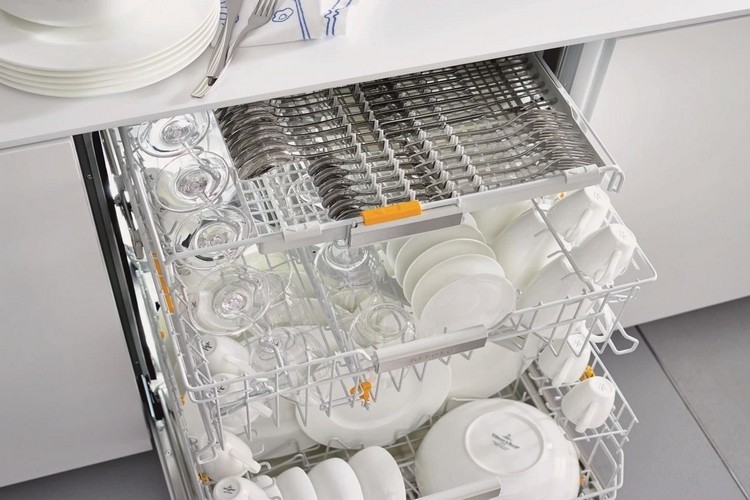What type of drying for your dishwasher: condensation, intensive, zeolite
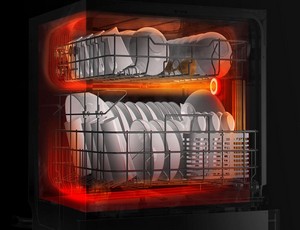 Only 20 years ago, a dishwasher was a luxury item; now it's a must-have accessory in the kitchen.
Only 20 years ago, a dishwasher was a luxury item; now it's a must-have accessory in the kitchen.
And the potential buyer is more interested in what type of drying system to choose..
And how does it affect the operation of the dishwasher in general? What should you pay attention to when buying it?
Contents
Dishwasher and dryer working principle
The general algorithm of operation of such equipment is as follows:
- After putting dirty dishes into the tank, the user selects the washing mode. Their number depends directly on the manufacturer and what algorithms have been laid by them in the control board.
- Cold water is taken from the mains, heated to a predetermined temperature by a heating element.
- The hot water is mixed with a special detergent, sprayed through rotating nozzles on the dishes. Due to the powerful jet it allows you to cope even with the most difficult dirt.
- Dirty water is discharged together with the detergent into the drain.
- The technique again draws cold water, already without heating.
- The dishes are rinsed.
- After the washing program is completed, drying is performed.
This is the basic algorithm by which this technique works. But some manufacturers provide additional functions, such as installing several nozzles or increasing the internal pressure by pre-injecting air.
Energy efficiency classes of different types of dryers and the DHR in general
The following formula is used to calculate the energy efficiency of the PMM:
- Calculate how much the appliance consumes in standby mode for 1 year;
- To the received number add the power consumption for 280 washing and drying cycles (an average value of how many times during the year the average user starts the dishwasher).
The calculated value is 462 kWh per year. For the appliances to get the energy efficiency class A+++ it is necessary that its classification is up to 50%. That is, such a washing machine must consume up to 231 kWh.
Accordingly, knowing the energy efficiency class, you can understand how much electricity the dishwasher will consume on average per year. Today, the average value is 300 kWh.
What does the energy consumption depend on? Primarily on the power of the installed heating element and the algorithm of drying the dishes.
The most economical are the washing machines with zeolite system. The least energy-efficient ones are the ones with turbo dryer. But each of the drying options has both advantages and disadvantages.
Condensation drying
One of the very first algorithms that began to be used in dishwashers.
It is performed as follows:
- After the rinsing process is completed, hot steam treatment of the dishes is turned on;
- The dishes are heated, the hot steam rises up and settles on the walls of the metal tank of the PMM, with the help of special drains is discharged into the tray.
That is, a heating element is used to heat water and obtain hot steam.
The main advantage of such PMs - it's low cost and relatively simple design. If necessary, they will not be difficult to repair.
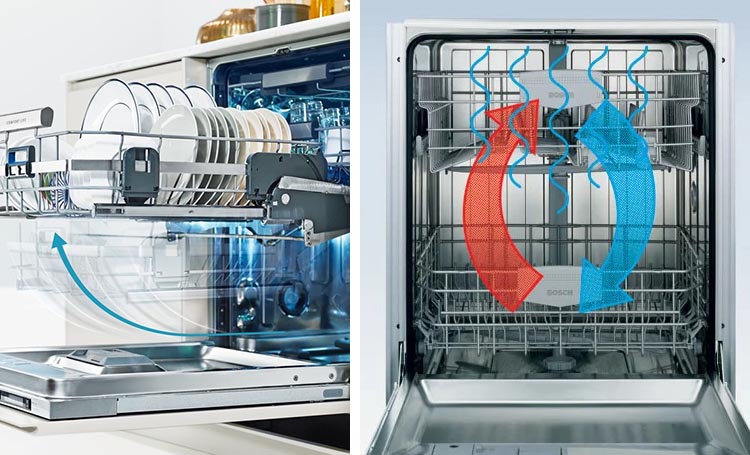
Ventilation drying
There are two variations of this drying mechanism used in modern dishwashers:
- Non-condensation drying. After the rinse is complete, the machine automatically opens the door 10 to 15 centimeters, allowing natural ventilation inside the tank. The main disadvantage of this method is that it leaves streaks both on the dishes themselves and on the inner walls of the machine, so it has to be cleaned often.
- With condensation treatment. First the dishes are steamed with hot steam, and after all the processes are completed - the door is automatically opened ajar. Now this option can be found practically in all budget class PMs.
That is ventilation is provided only by the fact that the door in a dishwasher is ajar after all the programmed processes are completed.
Naturally, most of the condensate remains directly in the PM, but some gets out. That is why it is mandatory to have forced ventilation in the room.
But the cost of such machines is relatively low.
Technically, they differ from condensing ones only in the presence of an automatic door opening mechanism, as well as a special sensor that determines the current humidity inside (to determine when the door will be opened).
Turbo dryer
The fastest drying option.
The basic algorithm - as in the condensation, but there is also a special fan, blowing hot steam inside the washing machine. That is, it speeds up the process of blowing hot air on all the contents and condensation on the walls.
In some machines also after that the door is ajar and the fan works for some more time.
The main disadvantage of this scheme is the high consumption of electricity, as well as the presence of additional noise during operation. And as practice shows, coolers and fans fail quite quickly (after 3 - 5 years they have to be fully serviced, replacement of gaskets, bearings and so on, and in some manufacturers the design is indestructible).
Some machines have also a turbo dryer system for heating the air inside the automatic machine by turning on the heating element for a short period of time. Naturally, this also affects the power consumption of the equipment.
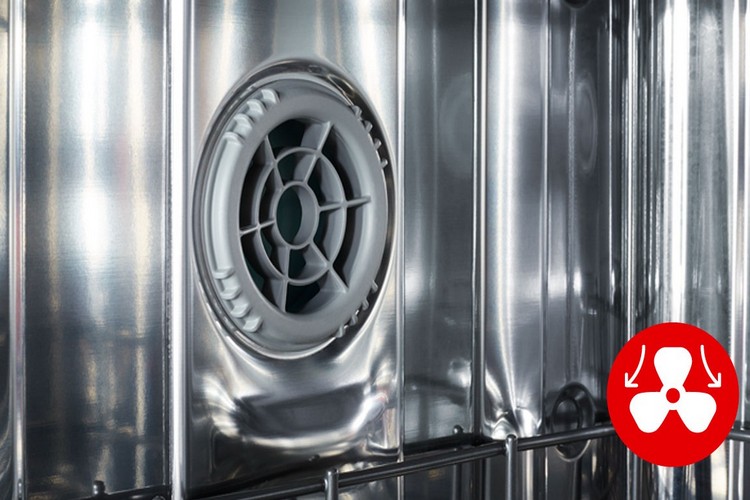
Intense drying
It is an analogue of turbo drying, but these dishwashers do not have a built-in fan.
Circulation of air is achieved by creating a pressure differential inside the PMM as well as outside. There are several valves on the cabinet which are opened after the rinse is finished. Due to the pressure difference, the air is automatically "drawn" inward, causing the air masses to move. This speeds up the drying process, but without the involvement of the heater and fan.
Such dishwashers have a high energy efficiency class, but it is necessary to periodically check the functionality of the valves (clogging can occur).
Also intensive dryers are more "sensitive" to the ambient temperature. The higher it is, the less efficient the process of drying dishes (due to less difference in temperature).
Therefore they are practically not used in restaurant kitchens, where high temperature inside the room is a normal working environment.
Zeolite drying
Today it is the most "advanced" option of drying in dishwashers. But it can be found only in the luxury class washing machines, which are 2 - 3 times more expensive than the most common models.
The technology is as follows:
- Zeolite, a mineral capable of absorbing heat in large quantities, is placed in the tray. At the same time its heat transfer coefficient is as high as, for example, that of copper, although it weighs an order of magnitude less.
- Upon completion of the rinsing process the zeolite naturally heats up the air inside the dishwasher, thus speeding up the drying process. That is, a natural circulation occurs and the condensed moisture flows down the walls into the pan. This entire process takes, on average, 15 to 20 minutes. The door, as a rule, is not opened after that (there are separate air ducts providing natural moisture evaporation).
Zeolite does not consume electricity and does not require any maintenance from the user. But the drying process itself takes longer than with turbo drying.
Which drying process is better
The following conclusions can be drawn:
- Condensation drying - this is the simplest option in technical terms. It will not save significantly on electricity, also on dishes may remain stains (especially glassware). But the main advantage of a washing machine with such a variant of drying dishes is their low cost.
- Ventilation. A more modernized version of condensation, but the basic principle is similar. The process is slightly faster, but the streaks still remain. Also such PMs can be used only in rooms with good natural ventilation or forced ventilation (that is, where there is a ventilation system).
- Turbo-dryer. Option for those who have to use the dishwasher frequently (for example, a large family). They are also installed in catering establishments.
- Intense. Relatively modern type of drying, in which the manufacturers tried to take into account the advantages and disadvantages of previous options. It takes a little longer than turbo drying, but it doesn't leave any streaks, and also the electricity consumption is quite low. Dishwashers with intensive drying in 99% of cases have energy efficiency class A+ or A++.
- Zeolite. The best option, but expensive. Therefore, not everyone will be able to afford to install such a dishwasher. And also such equipment weighs more, also takes a little more free space. But zeolite is absolutely environmentally friendly, resistant to long-term temperature effects mineral. So such a dryer will never break down. And you do not need to use a heating element or a fan, since the heated air naturally rises to the top of the dishwasher.
To summarize, the general principle of operation of all the automatic dishwashers is the same.
Only the mechanism of drying dishes differs significantly. And this should definitely be paid attention to, if the buyer does not want to face the constant stains on the kitchen utensils. If it is not important for ordinary plates, pots, but when it comes to washing crystal or glassware, all the disadvantages become apparent.
And it is necessary to take into account the power consumption, because electricity prices are regularly rising, and the PM is one of those appliances that consumes a lot of current.
Useful Video
After watching this short video you'll learn what types of dryers there are in dishwashers, and which one to choose:



